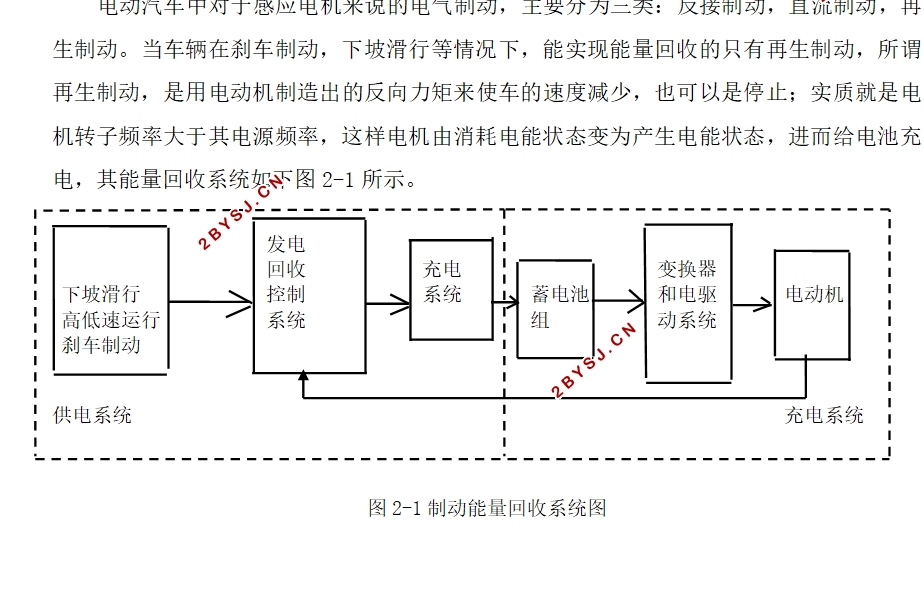纯电动汽车制动能量的自动回收研究(附Matlab仿真)
无需注册登录,支付后按照提示操作即可获取该资料.
纯电动汽车制动能量的自动回收研究(附Matlab仿真)(任务书,开题报告,外文翻译,论文26000字,Matlab仿真)
摘 要
随着21世纪经济的迅猛发展,人们生活水平的日益提高,越来越多的人拥有了属于自己小汽车,它极大地改变了人们的生活方式和思维方法。但是随之而来一些问题,也逐渐成为人们关注的焦点,人们的生活和人类的健康受到汽车排放尾气的严重影响。与此同时,逐渐增长的汽车数量和日益减少的能源形成了严重的矛盾。因此,各个国家都出台了相关政策法规来激励零排放、零污染的新能源汽车的研发与使用。但是纯电动汽车这一产业的发展受到一些关键技术的制约,比如电动车充一次电的续航能力远远不能满足人们的实际需求,所以在如何增加续驶能力这方面出现了一个新的研究课题,就是回收电动汽车的制动能量。
本论文为了实现这一课题的研究,查阅了大量与此相关的文献。由于在国内对这一课题的研究还在起步阶段,本论文也在努力做出一些有效的发现与成果。纯电动汽车的行驶需要驱动电机消耗电能,但是汽车在制动的时候,将制动能量回收通过驱动电机转化为电能,给蓄电池充电,这将极大地增加了汽车续驶里程。但是制动能量涉及到电池与电机各个部分、机械传动部分等。因此,要综合考虑汽车动力学特性、电机发电特性等多方面的问题。
本论文第一部分主要介绍了制动能量回收的基本原理,了解了国内外对这一技术的发展概况。结合电机发电特性,分析了制动过程,划分制动三种模式,以及提出了若干影响制动能量回收的约束条件。
论文第二部分介绍了汽车开环和闭环的控制系统。在制动能量回收约束条件下,综合考虑电池充电效率,电机发电效率还有机械传动效率。提出非线性制动能量回收算法。
论文第三部分建立制动能量回收的仿真模型,并用Simulink进行了实现。分析结果,并对该制动能量回收算法,模型进行了评价。
关键词:制动能量回收 约束条件 非线性算法 Simulink
Automatic Recovery of pure electric vehicle braking energy
Abstract
In the 21st century, the economy has been developing rapidly. With increasing people's living standards, more and more people have their own car, which greatly changed people's way of life and way of thinking. However, the ensuing problems have gradually become the focus attention, life and health of people severely affected by the automobile’s exhaust emissions. At the same time, gradually increasing the number of cars and dwindling energy have become a serious contradiction. Therefore, all the countries have introduced policies and regulations to encourage development and use of new energy vehicle with zero emission, zero pollution. However, the development of pure electric vehicles is constrainted by some of the industry's key technical, such as the electric car's battery life on one charge can not meet the actual needs of the people, so there is a new research topic on how to increase the driving capacity in this area , whitch braks energy recovery the electric vehicle.
In order to achieve the research of the paper’s subject, I read a lot of literature associated with this. Since the research is still in infancy on this topic in our country, I am also trying to make some valid discoveries and achievements. Drive motor of pure electric vehicle needs to consume energy, when the car is braking, the driving motor transforms the recovered braking energy into electricity to charge the battery, which will greatly increase the driving range of the car. But the braking energy involves all parts of the battery and motor, transmission parts and so on. Therefore, we have to consider the car’s dynamics and the characteristics of motor’s power generation.
The first part introduces the basic principles of the braking energy recovery,and let us understand overview of the development of this technology at home and abroad.I divid the braking into three modes by analyzing the braking process and combining the characteristics of motor’s power generation , as well as proposing many constraints that affect the braking energy recovery.
The second part describes the car’s open and closed loop control system. With the constraints of braking energy recovery, considering efficiency of the battery charging and electrical power generation as well as the mechanical transmission efficiency. I propose nonlinear braking energy recovery algorithms.
The third part of the paper build a simulation model of the braking energy recovery and implement by using Simulink.I analyze the results and evaluate the algorithm and model of braking energy recovery .
Keywords:Braking energy recover Constraint Nonlinear algorithm Simulink



目 录
摘 要 I
ABSTRACT II
第一章 绪论 1
1.1 课题研究背景、意义和现况 1
1.2 国内外纯电动汽车制动能量的自动回收研究现状 1
1.2.1纯电动汽车制动的研究现状 2
1.2.2纯电动汽车能量回收的研究现状 2
1.2.3纯电动汽车制动能量回收技术发展现状 3
1.3 本课题主要研究内容 4
1.4 课题应用前景 5
第二章 制动能量自动回收的原理及其影响因素 6
2.1 制动能量自动回收原理简介 6
2.2 纯电动汽车制动能量的回收原理 6
2.2.1 电驱动系统 8
2.2.2 电驱动系统驱动电机性能极其比较 8
2.2.3 三相交流异步电机 11
2.2.4 三相交流异步电机驱动控制系统 13
2.2.5 三相交流异步电机的再生制动 14
2.3 制动能量回收的影响因素 15
第三章 纯电动车再生制动的建模 18
3.1 纯电动汽车制动过程的数学模型 18
3.1.1 电动车的驱动力 18
3.1.2 电动车的行驶阻力 20
3.2 纯电动汽车的制动性和制动模式 24
3.2.1 制动性的评价指标 24
3.2.2 制动效能 25
3.2.3 制动模式 28
3.3 制动过程的动力学分析 29
第四章 基于制动能量回收的非线性算法 33
4.1 纯电动汽车驱动控制系统的研究 33
4.1.1 纯电动汽车在运行过程中的开环系统 33
4.1.2 纯电动汽车在运行过程中的闭环系统 34
4.1.3 以驾驶员作为传递函数的研究 34
4.1.4 回收制动能量的规律 35
4.2 基于制动能量回收的非线性算法 36
4.2.1 建立回收制动能量的非线性模型 36
4.2.2 遗传算法优化步骤 37
4.2.3 制动能量回收的算法 38
4.3 制动能量回收的MATLAB仿真 41
4.3.1 MATLAB仿真及其组件SIMULINK的简介 41
4.3.2 制动能量回收仿真模型 42
第五章 制动能量回收的总结与展望 44
5.1 制动能量回收的总结与展望 44
致 谢 45
参考文献 46
